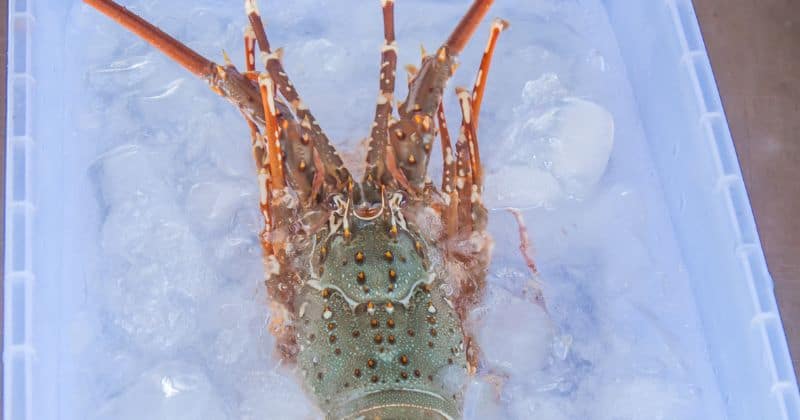Are you a lobster lover? Are you worried about the potential health risks of consuming this seafood delicacy?
If so, you’re not alone. In this blog post, we’ll discuss the potential parasites and bacteria found in lobster meat and the steps you can take to minimize these risks.
Lobster meat can contain parasites, including roundworms and tapeworms, and harmful bacteria like Vibrio species. But don’t worry – cooking your lobster thoroughly can significantly reduce the risk of consuming these harmful organisms.
Throughout the rest of this article, we’ll also dive into other common lobster-related health concerns, such as mercury contamination and shellfish allergies, and provide tips on making informed lobster choices.
So if you’re ready to learn more about the potential risks and benefits of consuming lobster and other seafood, keep reading!
Can Lobster Meat Contain Parasites and Bacteria?

Yes, lobster meat can contain parasites and bacteria. But what exactly are these harmful microorganisms and how do they affect us? Let’s dive deeper and explore the topic further.
Bacteria in Lobster Meat
As mentioned before, bacteria can naturally exist in lobster meat and multiply rapidly after the lobster dies. Here are some of the specific types of bacteria that can be found in lobster meat:
Vibrio bacteria
These bacteria thrive in warm seawater and can cause illness in humans when consumed through contaminated seafood. Symptoms may include nausea, vomiting, and diarrhea.
Escherichia coli (E. coli)
This bacteria can cause severe food poisoning and may lead to kidney failure in some cases.
Listeria monocytogenes
This bacteria can cause listeriosis, a severe illness that can affect pregnant women, newborns, and elderly people.
Ciguatera
A type of toxin found in some marine animals, including lobsters in certain areas. It can cause nausea, vomiting, and neurological symptoms.
Parasites in Lobster Meat
Parasites can also be present in lobster meat, especially if the meat is undercooked. Here are some of the specific types of parasites that can be found in lobster meat:
Roundworms
These parasites are often found in the digestive tract of lobsters and can cause gastrointestinal symptoms in humans if ingested.
Tapeworms
These parasites can grow up to several feet in length and can cause serious health problems if ingested.
Nicothoë astaci (the ‘lobster louse’)
These parasites live on the surface of lobsters and can sometimes be found inside the meat. They are not harmful, but can be unsightly and indicate poor quality meat.
To reduce the risk of consuming parasites in lobster meat, it is essential to cook the meat thoroughly and avoid consuming raw or undercooked lobster.
Symptoms of Infection from Lobster Meat
Consuming undercooked or contaminated lobster meat can result in various symptoms depending on the type of infection. If you develop any of these symptoms after eating lobster, seek medical attention immediately.
Here are some symptoms associated with infections from lobster meat:
Gastrointestinal symptoms
Parasitic infections, such as those caused by roundworms and tapeworms, can cause gastrointestinal symptoms including nausea, vomiting, abdominal pain, and diarrhea.
Neurological symptoms
Ciguatera toxin found in some lobsters can lead to neurological symptoms such as tingling, numbness, and muscle weakness.
Shellfish poisoning
Symptoms of shellfish poisoning can include nausea, vomiting, and diarrhea which can appear 4-48 hours after consuming contaminated lobster.
Food poisoning
Consumption of raw or undercooked lobster meat can lead to bacterial infections such as salmonella and Vibrio, resulting in symptoms such as nausea, vomiting, and diarrhea.
Remember to always cook lobster meat thoroughly and avoid consuming raw or undercooked meat to reduce the risk of infection. If you suspect that you may have consumed contaminated lobster meat and are experiencing any of these symptoms, seek medical attention immediately.
Best Ways to Prepare and Cook Lobster to Ensure It’s Safe to Eat

To ensure that lobster meat is safe to eat, it is crucial to prepare and cook it properly. While lobster meat does have the potential to contain parasites, proper cooking can eliminate any harmful organisms.
Here are some best ways to prepare and cook lobster to ensure it is safe to eat:
1. Clean and handle the lobster properly
Before cooking the lobster, make sure to thoroughly clean it under running water with a stiff brush. Use caution when handling live lobsters to avoid injury from their sharp claws.
2. Cook the lobster thoroughly
Cooking the lobster thoroughly is essential in eliminating any parasites or harmful bacteria. Boiling or steaming it for at least 10-12 minutes, or until the internal temperature reaches 140°F, is recommended.
3. Avoid consuming raw or undercooked lobster
Raw or undercooked lobster meat can contain harmful bacteria or parasites and should be avoided. Ensure to cook the lobster meat until it is no longer translucent and turns opaque.
4. Store the lobster properly
If you are not cooking the lobster right away, store it in the refrigerator at 41°F or below. Cooked lobster can be stored in the refrigerator for 2-3 days.
By following these guidelines, you can ensure that your lobster is safe to eat and free from harmful parasites or bacteria. Remember to always cook your lobster thoroughly and avoid consuming raw or undercooked meat.
Other Seafood-Related Health Concerns
While proper preparation and cooking can eliminate harmful organisms in lobster meat, there are other seafood-related health concerns to be aware of.
Fish, for example, can contain harmful chemicals such as mercury, PCBs, dioxins, and pesticide residues that can build up in their bodies over time and harm the brain and nervous system.
Consuming fish that contain methylmercury can cause damage to the brain and other parts of the nervous system, particularly in pregnant women and young children.
That said, it is still vital to include seafood in your diet, as it provides essential nutrients like omega-3 fatty acids and protein.
Seafood parasites such as Anisakis simplex and cestodes (tapeworms) can also cause health hazards like allergic reactions, intestinal perforations, and even death in rare cases.
To reduce the risk of consuming seafood parasites, it is recommended to either cook the seafood thoroughly or freeze it for a certain period of time.
Lastly, PCBs have been associated with health effects in animal studies, including reproductive and developmental problems, immune system suppression, and cancer.
To reduce exposure to PCBs, it is recommended to consume a variety of fish from different sources and to avoid consuming large predatory fish like swordfish and sharks.
Mercury Contamination in Seafood
Seafood, including fish and shellfish, can contain mercury. While it is true that nearly all fish and shellfish contain traces of mercury, for most people, the risk from mercury by eating fish and shellfish is not a health concern.
However, some fish and shellfish contain higher levels of mercury that can harm an unborn baby or young child’s developing nervous system, even in small amounts.
The ingestion of methylmercury, a highly toxic organomercury compound that fish and shellfish concentrate in their bodies, can cause serious health problems such as damage to the brain and nervous system. Pregnant women and young children are particularly vulnerable to mercury exposure.
To minimize the risk of mercury contamination, it is recommended to avoid consuming large predatory fish like sharks and swordfish, which contain the highest levels of mercury.
Opting for smaller fish like sardines or trout can also help reduce exposure. Canned light tuna and shrimp are among the most common types of seafood consumed in the United States, and they contain lower levels of mercury than other types of fish.
It is essential to be mindful of the source of seafood when consuming it to reduce the risk of mercury contamination. Eating seafood from reputable sources and choosing those known to have a low mercury level is a great way to minimize health risks.
Shellfish Allergies and Cross-Contamination
Shellfish allergies can be severe, and cross-contamination can occur in restaurants and markets where shellfish are often stored together.
Cross-contamination can also happen during manufacturing or in stores where other food is processed or displayed near shellfish. Due to the risk of cross-contact, individuals with a shellfish allergy may wish to avoid seafood restaurants or those that offer dishes made with shellfish.
However, it is essential to note that many shellfish-allergic people can eat mollusks like scallops, oysters, clams, and mussels with no problem.
Additionally, those with a shellfish allergy do not need to worry about cross-reactions with iodine or radiocontrast material.
Aside from allergies, another concern with shellfish consumption is the potential for parasite contamination. Lobsters, like other shellfish, have the potential to carry parasites. These parasites can cause infection in humans if the lobster meat is not properly cooked.
Some of the most common parasites found in lobster meat include Anisakis, which is usually found in raw or undercooked fish, and Vibrio, which can cause food poisoning if consumed.
Other parasites that can be found in lobster meat include Capillaria and Cryptosporidium.
To ensure that lobster meat is free of parasites, it is recommended to cook it thoroughly to an internal temperature of 145°F. Additionally, it is essential to handle raw lobster and other shellfish carefully to prevent cross-contamination with other foods and surfaces.





